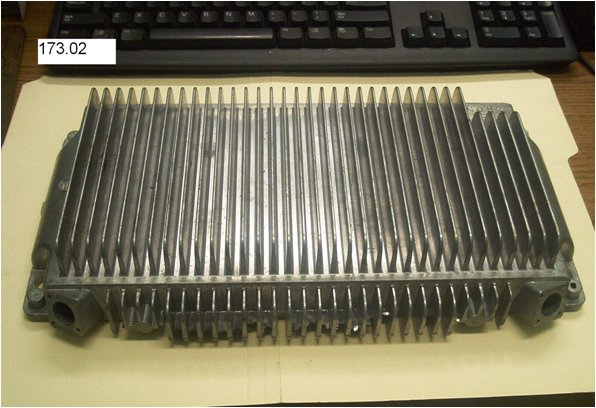Kinetic Die Casting Company has a Manufacturing Directory (www.kineticdiecasting.com/resources/index.php): Kinetic Die Casting Company Manufacturing Directory Kinetic Die Casting Company manufacturing directory for websites that would like to exchange links with www.Kineticdiecasting.com You are welcome to place your links in our …
Continue reading
Tag Archives: aluminum parts
Die Casting Parts RF/EMI Properties
RF/EMI shielding Die Casting Parts. Die Casting Parts RF/EMI Properties.
Aluminum is one of the most abundant “metallic” materials on earth. Aluminum is also one of the most electrically conductive materials. Because aluminum is electrically conductive, it is a natural shield for radio frequency waves.
 Aluminum Heat Sink Die Casting
Aluminum Heat Sink Die Casting
Kinetic Die Casting Company produces many types of aluminum die casting parts. Many times, an aluminum housing or enclosure was made from aluminum because of the natural electrical conductivity of aluminum.
The picture at the top of this newsletter is an electronic enclosure that was die cast in A413 aluminum because of its electronic EMI/RF properties. Perhaps, you should consider aluminum if you are thinking of designing a new electronic enclosure.
Kinetic Die Casting manufactures aluminum die castings creating aluminum die casting boxes, aluminum handle hardware, and aerospace die casting. If you would like to get a quote, please visit our website: Kinetic Die Casting Company
Different Die Casting Alloys for Different Purposes
Different Die Casting Alloys for Different Purposes. There are several die casting alloys that can be utilized to manufacture high grade and tremendously strong metallic parts like Aluminum die casting. Die casting requires the utilization of liquefied alloys which will be injected into molds to create metal parts.
Die casting alloys utilized for metal casting ought to have lower melting point. Alloys that can be thawed simply allows for faster production procedures and guards the die or mold from being injured.
For little metal parts, one of the finest die casting alloys that can be utilized is zinc. Zinc alloy is simpler to cast and have better ductility than other materials. It can also attain high impact strength. Most significantly, zinc alloy can be plated easily.Furthermore, you can use hot chamber zinc die casting, which also impacts the price of the part.
Aluminum on the other hand is very lightweight, simple to melt, and have better artistic qualities. By employing aluminum as die casting material, manufacturers can produce parts at a faster rate and can make parts like aluminum die cast boxes. That is because aluminum is very stable at high temperature and will cool faster thus reducing the threat of contamination and oxidation. Because of these, aluminum alloys can oppose corrosion better than other materials.
Other kinds of die casting alloys that are appropriate to use for high pressure and high temperature castings are magnesium, copper, lead and tin. Magnesium is the lightest alloy that can be utilized for casting while copper offer greater strength and high resistance to corrosion. Magnesium alloy is also inexpensive and easier to machine after production. Tin and lead on the other hand can be used to produce near finished parts.
Kinetic Die Casting manufactures a lot of aluminum rooftile plates , trim tile molds, and military die casting. If you would like a quote, please visit our website: Kinetic Die Casting Company
Which is the Right Die Casting Alloys
Which is the Right Die Casting Alloys. Choosing the alloy right for a component counts among the main concerns for casters and designers of die cast parts. They ought to be not only being well-versed on the different properties of die casting alloys. Their information should go further than the cost of each material and expand to a systematic examination of the drawbacks and rewards of each alloy. The thin walls and sections, for example, of a special design would need metals of better strength and fewer cubic inches.
Basically, there are six die casting alloys for deliberation. These are: aluminum, zinc, magnesium, copper (bronze), lead, and tin. The more scientific specifications of die casting alloys cover: zinc aluminum, AZ91D magnesium, ZAMAK alloy, AA 380, AA 384, AA 386, and AA 390. The exacting characteristics of each of these materials for die casting offer definite compensations for the designed component.
Aluminum, for instance, is light but possesses high dimensional constancy suitable for complicated designs and thin walls. It is corrosion-resistant, with great mechanical properties, high electrical and thermal conductivity, and retains strength even at high temperatures. Zinc, in contrast, enjoys the benefits of being simple to cast among other materials with its low melting point. It could be counted on for high impact strength and high ductility for a long-lived die. Simply plated, zinc materials stand as the finest die casting alloys for small parts.
Machining would be the simplest if magnesium is utilized as die casting alloys. Although it is the lightest alloy to die cast, magnesium boasts of a strength-to-weight ratio benefit. High hardness could be copied from copper, as well as high resistance to corrosion. With its mechanical properties highest among die cast materials, copper is wear-resistant, dimensionally stable and strength near that of steel components. High density is what lead and tin alloys bring to the die caster. They are the well-matched die casting alloys for components with tremendously close dimensions and those that require to be particularly corrosion-resistant.
Kinetic Die Casting is a die casting company specializing in aluminum and zinc parts. If you would like to request a quote, please visit our website:Kinetic Die Casting Company
The Basics of Cold Chamber Die Castings
The Basics of Cold Chamber Die Castings. Cold chamber die castings are a method of die casting that utilized, as an alternative of a hot chamber, a cold one. When starting the procedure, the liquefied metal is taken from the crucible and then place into a shot sleeve. Later, a hydraulically operated plunger pushes the melted metal into the die. In order to reduce the decline that typically happens during solidification, as many material as achievable is forced into the die cavity. Injection pressures typically have to reach over 10,000 PSY or 70,000 KPa in order for the machine to function the way it should.
Cold chamber die castings are more often than not crucial when the alloy is not qualified for utilization in hot-chamber machines for a range of reasons. Such metals that need the cold chamber include aluminum, copper, zinc and magnesium alloys. Beforehand, the materials must be thawed using a furnace. The problem with using cold chamber die castings is that the cycle time is a lot slower, since the melted metal requires to be transported to the cold-chamber machine from the furnace.
When die casting, the die cast tooling required are completed out of steel because classic cast iron cannot take high pressures. This can provide another setback to using the cold chamber, for the dies end up being very costly, since steel is a expensive metal. The dies can hold multiply cavities, or just one mold cavity, and there must be two dies – one for separation, and one for ejection of the finishing product which could be like aluminum tile molds. Many kinds of cold chamber machines are obtainable with a mixture of features, but all of them function at utmost competence.
Place a link to your website in our:
PR4 Directory of Manufacturers.
We get over 100,000 visitors a month, that can help your web site. Go to our Submit Link page and put your link in the best location for your type of web site.
We also have a location where your site will be displayed as a new web site in Latest Links.
The sites that get the most traffic are listed in the Top Hits Page.
Kinetic Die Casting utilizes die casting to manufacture parts like aluminum car parts, airplane parts, lighting parts and much, much more. If you would like to request a quote, please visit our website:Die Casting quote
Cold Chamber Die Castings
Cold Chamber Die Castings. Die casting method essentially consists of injecting molten metal under high pressure into a mold or die. It is an adaptable method of fabricating reusable steel molds. The molds are planned to manufacture intricate shapes with high degree of correctness and repeatability. There are two primary processes in die casting, hot chamber and cold chamber.
Hot chamber die castings are utilized for alloys with low melting pot that do not readily attack and wear away metal pots, cylinders and plungers. While cold chamber die castings are utilized for alloys with high melting points like aluminum alloy casting, most ordinary of which is aluminum.
Cold chamber die castings make use of manual method in pouring molten metal. A hydraulic operated plunger will close the cold chamber port. Then, it forces metal into the locked die at very high pressure. The machine uses a disconnected melting furnace and weighs quite a lot of pounds.
The cold chamber die casting machine is situated outside the furnace, as evaluated to hot chamber zinc die casting. Thus, it entails a means of moving the melted alloy from holding furnace to the cold chamber which is fastened between the die casting machine front platen and the die. Transporting the melted metal is normally done with a ladle mechanism. Cycle times can vary between 10 seconds for smaller machines and up to 2 minutes for larger ones.
Cold chamber die casting is more well-liked in the manufacturing industry because of its inexpensive production cost and toughness. It may be more intricate than hot chamber die casting but its steadiness is more beneficial.
Kinetic Die Casting makes great quality aluminum, and Zinc Die Casting If looking for a job or would like a quote please visit our website:Kinetic Die Casting Company

